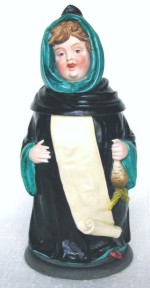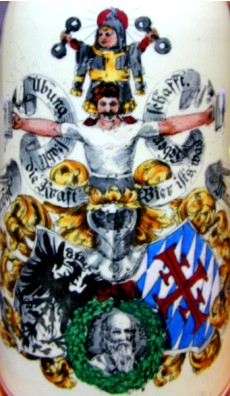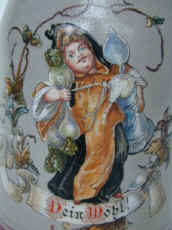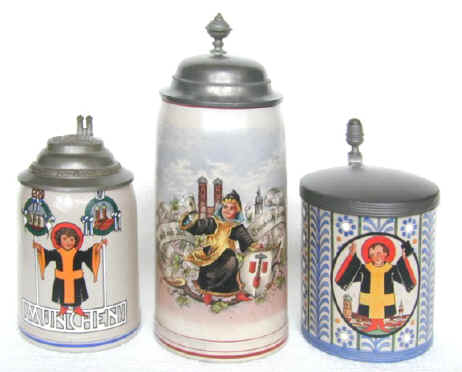Stein Collectors International
 ~ History of the
Munich Child ~
~ History of the
Munich Child ~
by Jack Lowenstein
| This article was originally
printed in
Prosit, the official journal of Stein Collectors International, in
September,
1968. New illustrations have been provided. The author, an SCI Master Steinologist, was the Executive Director and Editor of Prosit from 1978 to 1993. Jack developed an identity crisis with the Munchner Kindl, limiting his collection to steins featuring the beloved symbol of Munich, and appearing at many SCI conventions in full costume.
All stein collectors are familiar with the picture of a child, dressed in a cowl, with radishes in one hand, a filled beer stein in the other, smiling devilishly from a stein decoration. The saying on the stein is usually Gruss aus München, or translated, "Regards from Munich". But how many collectors know that this figure is really a semi-comic take-off of the official Munich coat-of-arms? Here are a few historic notes about Munich, its coat-of-arms, and the Munich Child (Münchner Kindl): The first written proof of Munich as a small settlement of monks dates from 1158 A.D. With the increase of the population, the town administration developed a constitution of the council. Soon a seal was used to prove the authenticity of town-council documents. The oldest seal of Munich, of which only fragments are left, with the presumable inscription "Sigillum Civitatis Monacensis" and the picture of a monk wearing an open hood, appears on a document of May 28, 1239. In the course of the following centuries a number of slightly varying representations of the seal were used. But all of them show the monk with the book (of city laws) in his left hand, while his right hand with three outstretched fingers is held up. Next to most of these seals is shown a town gate and an eagle, which, in the fourteenth century, is replaced by a lion (of the coat-of-arms of the reigning dynasty of the Wittelsbachs). For some time the monk was represented in profile, later full-face and bare-headed. Colorful representations of the town coat-of-arms go back to the fifteenth century. From then on the features of the heraldic figure began to lose their serious character, the face became more youthful, the hair sometimes even curly. The present form of the official coat-of-arms with a monk in black cowl, (law) book and blessing in right hand, was given to Munich by the reigning king, Louis I, on September 16, 1834. At the request of the Magistrate of the city, King Louis II (he was the king who, in 1886 was drowned in the lake of Starnberg) granted minor changes in the coat-of-arms on June 11, 1865, from his castle at Berg (the book and shoes of the monk were given a red color). Since that time no further significant changes have been made.  It is
not known when the "Munich Child" (Munchner Kindl) appeared in
the coat-of-arms for the first time or who gave it the sympathetic
name. Some
representations of the fifteenth century already show the child figure
instead
of the monk. The metamorphosis was not brought about by some order of
the
sovereign, but instead by artists, by the seal and copper engravers, by
the
sculptors and painters who transformed the old bearded town-monk into a
curly-haired child resembling the Christ child who appears with
blessing hands
on the altars at Christmas. A medallion which the town gave in 1577 to
the
Brotherhood of crossbow marksmen, as well as painted "cartoons" of
1579, show the "Munich Child". It is
not known when the "Munich Child" (Munchner Kindl) appeared in
the coat-of-arms for the first time or who gave it the sympathetic
name. Some
representations of the fifteenth century already show the child figure
instead
of the monk. The metamorphosis was not brought about by some order of
the
sovereign, but instead by artists, by the seal and copper engravers, by
the
sculptors and painters who transformed the old bearded town-monk into a
curly-haired child resembling the Christ child who appears with
blessing hands
on the altars at Christmas. A medallion which the town gave in 1577 to
the
Brotherhood of crossbow marksmen, as well as painted "cartoons" of
1579, show the "Munich Child". The most charming impression is given by a miniature, dating to 1686, in the town law book showing the "Munich Child" with a red halo. These old representations of a child instead of a monk are among the possessions of the Historical Museum of the City of Munich and the City Archives.  The good humor and
inexhaustible fancy of Munich artists of the second half of the
nineteenth
century added various supplements to the image of the child: a laurel wreath, a
foaming
beer stein, radishes and pretzels.
These humorous additions made the Munchner Kindl the well-known
symbol
and guardian spirit of the city and its festive events. I The good humor and
inexhaustible fancy of Munich artists of the second half of the
nineteenth
century added various supplements to the image of the child: a laurel wreath, a
foaming
beer stein, radishes and pretzels.
These humorous additions made the Munchner Kindl the well-known
symbol
and guardian spirit of the city and its festive events. I In the scene to the right, the Munich Child sits atop the shoulders of a competitor in the VII. Deutsches Turnfest held in Munich in 1889. The two seem to have switched their normal burdens, as the man holds out two filled beer steins, while the Munchner Kindl raises two barbells! Interesting differences in the representation of the child are the rule rather than the exception. The child appears with and without hood or halo, with radishes in either hand, with the book of law or a pretzel, with hand extended in a blessing or holding barbells at a Turnfest.  For a long time the "Munich Child" was a boy who did not deny his
artistic descent from the town monk. Around 1890, Munich artists, in
the fashion
of the fin de siecle, began to represent the child as a girl.
For a long time the "Munich Child" was a boy who did not deny his
artistic descent from the town monk. Around 1890, Munich artists, in
the fashion
of the fin de siecle, began to represent the child as a girl. But the child figure in the seal and on the steins has no official character. The monk-head still graces the official seal! Nevertheless, apart from all heraldic art and science, the merry Munchner Kindl represents a phemomenon in the history of civilization. And we hope that the next time you drink from a Munich stein you will recall this brief history and metamorphosis of the "Child of Munich". Sources: "Der Monch im Wappen", Verlag Schnell & Steiner, Munich, 1960. "Münchens Stadtwappen und das Münchner Kindl", by Ernest von Destouches, in the periodical Kunst und Handwerk, Vol. 10, 1905. Personal communications from the Office of the Mayor, Munich. |
